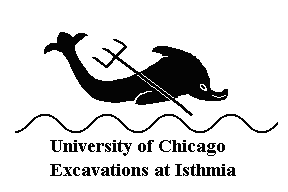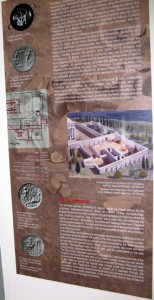UNIVERSITY OF CHICAGO EXCAVATIONS AT ISTHMIA, 2008

SITE and MUSEUM:
Renovation of the site and museum through a grant from the European Fund for Rural Improvements and Third Community Support Budget was virtually completed in 2008. The project is administered by the Λ Ζ (37th) Ephoreia of Prehistoric and Classical Antiquities of the Hellenic Ministry of Culture under the direction of the ephor, Dr. Konstantinos Kissas. Selected photographs of the cases accompany this report, Figures 1-4.
CONFERENCE PAPERS: Papers delivered in June 2007 at the conference: “Half a Century on the Isthmus: A conference to celebrate over fifty years of excavation and survey on the Isthmus of Corinth” were received and reviewed by Elizabeth Gebhard and Tim Gregory. The volume will be submitted to the Publications Committee of the American School of Classical Studies in Athens.
ARCHAIC TEMPLE Fritz Hemans
Further study confirmed the elevation of the floors of the pteron and the top of the stylobate at ca.0.00 m. The block that Oscar Broneer identified as a step at the southeast corner of the façade was found to belong to a foundation for the stylobate.
The vertical surface on the circular base interpreted as supporting the marble perirrhanterion at the northeast pteron of the temple bears evidence of being set into the floor before being finished, and the floor was evidently laid at the same time against the sides of the base (Figure 5). The monument can now be understood as contemporary with construction of the temple. The same may be true of an iron tripod of the 7th century B.C., the feet of which were found in situ adjacent to the perirrhanterion base.
LATE ARCHAIC AND CLASSICAL CERAMICS Martha Risser, Brian Cheney, Elyssa Michael
Recent study of the distribution of cooking wares shows that the roasting and the boiling of sacrificial meat were generally done in different parts of the sanctuary during this period, some meat roasted at the altar and the remainder boiled in proximity to the communal feast. Some of the stewpots and covered serving platters from the reservoir (Large Circular Pit) are unusually large, while vessels used for individual servings are slightly smaller than similar examples found in domestic contexts in nearby Corinth. Kotylai, skyphoi, and one-handled cups may have fulfilled a dual function at the feast, used both as bowls for food and cups for wine.
ARMS AND ARMOR Alastar Jackson
Analysis and study of the weapons and armor continued.
WORKED STONE TOOLS Ivan Gatsov, Petranka Nadelzheva.
The catalogue of objects relating to food production (querns and other grinding stones), construction tools (masons’ floats and hammers), game boards and a sun dial nears completion. Christopher Hayward, an expert on Corinthian quarries, identified the stone.
Respectfully submitted,
Elizabeth Gebhard, Director





